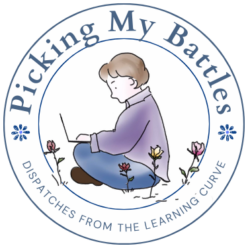
A week ago I got the prescription. Two days later I picked it up. I’m not functioning. These magic pills feel like my last straws, but I still can’t bring myself to open the bottle.
It’s been twenty-odd years since I last turned to Prozac. The drug and the disease it’s meant to treat are both better understood, and I understand I’m at that place where I need help that can’t come from myself or another human. I’ve tried other magic pills and management methods. Some of them get me out of the cave for a while, but, as the characters on my favorite guilty pleasure show ‘Once Upon a Time’ are fond of saying, All magic comes with a price.
Managing the big “D” with tricks means getting through it, but it also means experiencing every throb of worry and pain in every nerve. It means that tears are always waiting in the wings for the weak moments as over-analysis of very interaction keeps the psyche in a constant state of almost-adolescent angst. The magic pills dull that pain, but they do have a price.
Some cause weight gain (pretty depressing). Others lead to all nighters for nights on end. But all of them, while evening the keel and pulling my attention from the depths back to the horizon, wrap themselves around the soul like a neoprene wetsuit. It’s not a straight jacket, but the thick, impenetrable insulation does inhibit sensation. It’s a price, and the question I ask of every bottle of magic pills is how much?
The last year has been the most creatively-productive one I’ve ever known. Stimulated by new friendships forged at a writer’s workshop at Hubbard Hall in Cambridge, NY, I’ve written and drawn more and more regularly than ever before. Before the workshop, I was a dabbler, trying to choose between two crafts and vacillating between them as the mood struck me. A year of unprecedented encouragement offered a more rewarding search for authenticity in our work. The workshop which started with a focus on rural and small town life ultimately became the search for the stories and meanings in all of our lives.
That search meant opening my eyes and my soul. It meant discovering beauty and meaning in my very ordinary life. It meant living life and recognizing the ways I had kept it out.
Depression doesn’t keep life out. It keeps me withdrawn from life, watching it from my cave, but I’m never quite sure if the pills are a way out of the cave or just a way to be less aware of it. It’s that uncertain but sometimes strong anesthetic effect that makes me fear the cure as much as the disease.
But there’s another uncomfortable reality. The deeper I go, the less I write. Not ironically, and the less I write, the deeper I go.
There’s a romantic picture of the tortured artist. It isn’t entirely unfounded. There is an frighteningly long list of authors and artists whose lives were upended and prematurely ended by mental illness.
However, as I struggle to work at the one occupation that truly gives me satisfaction, I’ve begun to wonder how much of their ability to express their creativity was actually hamstrung by their cranial chemical imbalances. Mania may produce periods of intense productivity, but, as I study the lives of the luminaries, it seems that the despair at other end of the spectrum often coincided with a withdrawal from life and work.
By contrast, the few people I’ve met in ‘real life’ who are working as artists or writers, are the ones who have managed their moods to allows themselves to ‘show up for work’ everyday. There is no drama in the work. There is only the work, as there is with any other job.
Right now, I feel constantly in jeopardy of failing the day job and the parenting job – forget achieving the dream job of writing. I know only fear of the unknown keeps the pills in their bottle, but int this moment the pursuit of the authentic is yielding one other invaluable lesson. It is that fear can be as crippling and counterproductive as any mental illness, and, while the debate over the link between creativity and mental illness thrives, my small hope is that conquering my fear of what might happen will be the stimulating cure to any analgesic effects of the curative I’m about to swallow.
Like this:
Like Loading...










